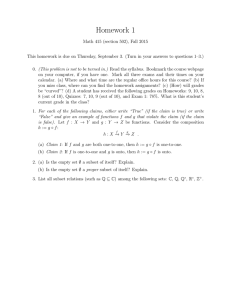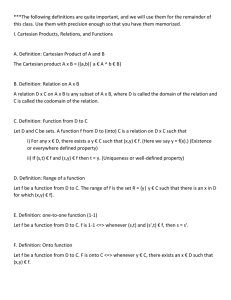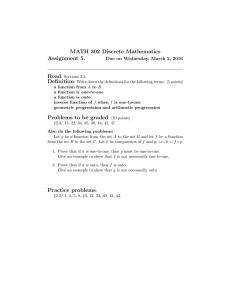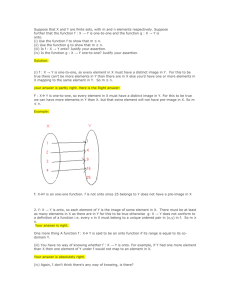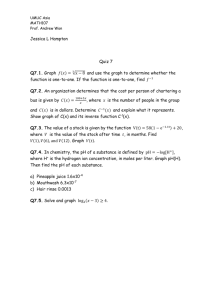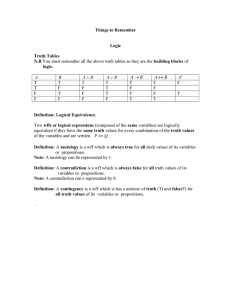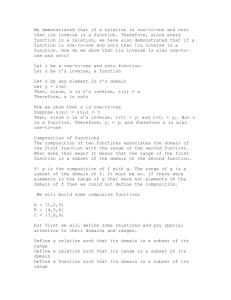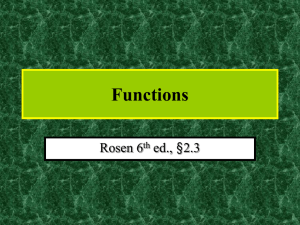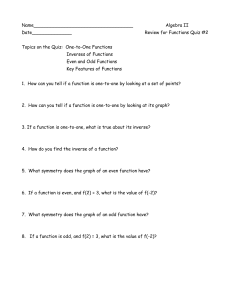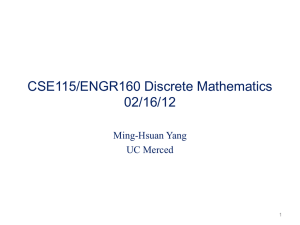Word doc
advertisement
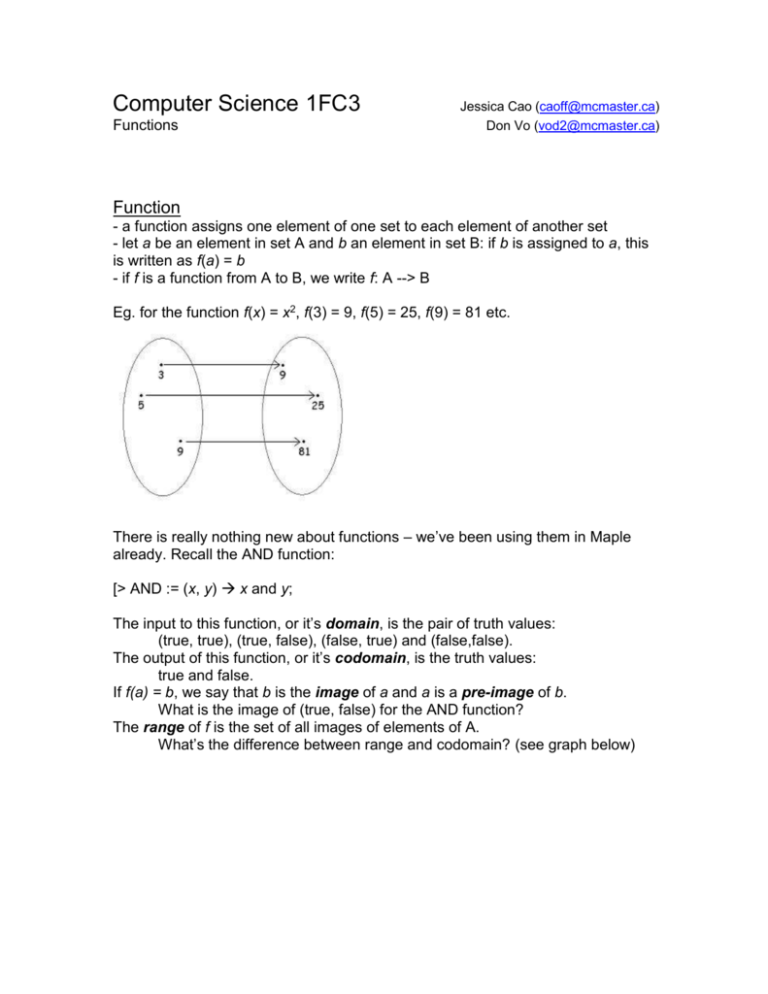
Computer Science 1FC3
Functions
Jessica Cao (caoff@mcmaster.ca)
Don Vo (vod2@mcmaster.ca)
Function
- a function assigns one element of one set to each element of another set
- let a be an element in set A and b an element in set B: if b is assigned to a, this
is written as f(a) = b
- if f is a function from A to B, we write f: A --> B
Eg. for the function f(x) = x2, f(3) = 9, f(5) = 25, f(9) = 81 etc.
There is really nothing new about functions – we’ve been using them in Maple
already. Recall the AND function:
[> AND := (x, y) x and y;
The input to this function, or it’s domain, is the pair of truth values:
(true, true), (true, false), (false, true) and (false,false).
The output of this function, or it’s codomain, is the truth values:
true and false.
If f(a) = b, we say that b is the image of a and a is a pre-image of b.
What is the image of (true, false) for the AND function?
The range of f is the set of all images of elements of A.
What’s the difference between range and codomain? (see graph below)
Real-valued functions with the same domain can be added and multiplied:
(f1 + f2)(x) = f1(x) + f2(x)
(f 1 f 2)(x) = f1(x)f2(x)
What do you think is the domain and codomain of (f1 + f2) and f1f2?
Subset
- if S is a subset of A, the image of S is the subset of B that consists of the
images of the elements of S.
- f(S) is the image of S, so that f(S) = {f(s) | s element of S}
One-to-one functions
- also called injective functions
- a function is an injection if and only if f(x) = f(y) implies that x = y for all x and y
in the domain of f.
- what is an example of an one-to-one function?
Increasing/Decreasing functions
- a function f is strictly increasing if f(x) < f(y) whenever x < y and x and y are in
the domain of f
- what do you think a strictly decreasing function is?
Onto functions
- also called surjective functions
- a function is a surjection if and only if for every element b element of B there is
an element a element of A with f(a) = b.
- what is an example of an onto function?
One-to-one Correspondence
- a function is a one-to-one correspondence, or a bijection, if it is both one-to-one
and onto.
- what is an example of an bijection?
Inverse function
- assigns to an element b belonging to B the unique element a in A such that f(a)
=b
- denoted by f -1
- f -1(b) = a when f(a) = b
- what is the inverse function of f(x) = x2?
Composite functions
- the composition of two functions f and g is denoted by f ○g
- (f ○g)(a) = f(g(a))
Exercises
1) For the following functions, state the i) domain ii) codomain iii) image iv)
range
a)
b)
c)
f: ℤ→ℤ, f(x) = x + 1
f: ℕ→ℕ, f(x) = ⌊100 / x ⌋
d)
2) Describe the following functions as one-to-one, onto, bijective or none of the
above.
Does the function have an inverse? If so, find it.
a)
f: ℤ→ℤ, f(x) = x – 1
c)
g: A→B where A = {1, 4, 7, 13, 42} and B = {2, 4, 108,
256} and g = {(1, 108), (4, 256), (7, 2), (13, 4)}
d)
g: A→B where A = {10, 42, 64, 111} and B = {2, 4, 108,
256, 720} and g = {(10, 4), (42, 2), (64, 2), (111, 720)}
e)
h: A→B where A = {a, b, x, y} and B = {$, #, %, !} and
h = {(a, !), (b, %), (x, $), (y, #)}
f)
f: ℝ→ℝ, f(x) = x2 + 1
b)
g)
f: ℕ→ℕ, f(x) = 2x
f: ℝ→ℝ, f(x) = x3
3) Determine the function that results from the composition, f ∘g.
a) f
c)
= x + 2, g = x4
b) f
= 2x + 2, g = x/2
f = x2 + 4x + 3, g = (x2 – 5)/(x + 13)

